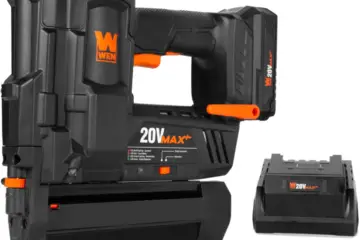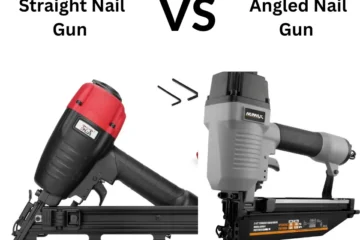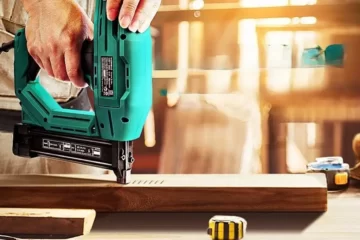When it comes to woodworking and home improvement projects, choosing the right tools can make all the difference. Among the various types of nailers available, the Brad Nailer and Finish Nailer are two popular options, each serving a specific purpose. But how do you decide which one to use?
In this comprehensive guide, we’ll explore the key differences, benefits, and best use cases for each, so you can confidently choose the right tool for your next project.
What You’ll Learn in This Guide
- A detailed comparison between brad nailers and finish nailers.
- When and where to use each type of nailer.
- Tips from experienced professionals on how to get the best results.
- Answers to common questions about Brad and finish nailers.
Brad Nailer vs Finish Nailer: The Basics
What is a Brad Nailer?
A Brad Nailer is a lightweight, versatile tool that uses 18-gauge brad nails. These nails are thinner and have less holding power compared to other nail sizes.
Brad nailers are perfect for delicate woodworking tasks because they leave small holes that are less noticeable, which means less finishing work is required.
- Nail Size: 18-gauge brad nails (0.0475 inches thick).
- Best Uses: Small trim work, baseboards, crown molding, cabinetry, and other delicate tasks.
- Typical Features: Compact size, easy to maneuver in tight spaces.
Pros of Brad Nailers:
- Ideal for lightweight and thin materials.
- Minimal damage to workpieces due to smaller nails.
- Often don’t require wood putty for hole filling.
Cons of Brad Nailers:
- Limited holding power for larger materials.
- Not suitable for heavy-duty tasks like framing or installing large baseboards.
What is a Finish Nailer?
A Finish Nailer, on the other hand, uses thicker 15 or 16-gauge nails. These nails offer more holding power, making finish nailers ideal for heavier tasks like attaching large baseboards, door casings, and furniture assembly.
- Nail Size: 15-gauge (0.072 inches thick) or 16-gauge (0.0625 inches thick).
- Best Uses: Heavier trim work, baseboards, crown molding, and larger woodworking tasks.
- Typical Features: Stronger nails, more powerful, often heavier.
Pros of Finish Nailers:
- Provides a strong hold, perfect for thicker materials.
- Great for larger trim and molding projects.
Cons of Finish Nailers:
- Larger nails leave bigger holes, requiring more finishing work.
- Heavier and bulkier compared to Brad nailers, which may limit maneuverability in tight spaces.
Brad Nailer vs Finish Nailer: Key Differences
Now that you have a basic understanding of what each tool does, let’s compare the two side by side:
| Feature | Brad Nailer | Finish Nailer |
| Nail Size | 18-gauge (thin) | 15-gauge or 16-gauge (thicker) |
| Best For | Delicate trim work, light-duty tasks | Heavy trim work, baseboards, crown molding |
| Holding Power | Lower holding power, good for thin materials | Higher holding power, good for thick materials |
| Hole Size | Small, often doesn’t need filling | Larger, needs filling and sanding |
| Tool Size | Lightweight and compact | Larger and more powerful |
Practical Example:
Imagine you’re installing crown molding in your living room. If the molding is lightweight, a brad nailer will likely suffice, allowing you to install the trim with minimal touch-ups.
However, for heavier baseboards or door casings, a finish nailer’s stronger nails will provide better support and prevent the trim from coming loose over time.
Personal Experience: When I Chose the Wrong Tool
During one of my first DIY home improvement projects, I was tasked with installing baseboards in my dining room. Not fully understanding the difference between the two tools, I used a Brad nailer for the job.
While the nails initially held up, within a few weeks, the baseboards began to pull away from the wall. I had to redo the work using a finish nailer, which provided a much more secure hold.
This experience taught me that while brad nailers are fantastic for light, delicate tasks, finish nailers are the better choice for anything requiring durability and strength.
When to Use a Brad Nailer
Brad nailers are ideal for situations where subtlety and precision are more important than sheer holding power. Because brad nails are so small, they leave tiny holes that don’t require filling in most cases.
Best Use Cases for Brad Nailers:
- Small Trim and Molding: Brad nailers are perfect for thin, lightweight trim where large nails would split the wood.
- Cabinetry: For securing small parts of cabinets or attaching thin panels, a brad nailer is the go-to tool.
- Picture Frames: Brad nailers provide a delicate touch, ensuring the frame isn’t damaged by larger nails.
- Crafts and Small Projects: The small size and precise control of a brad nailer make it perfect for DIY crafts.
Expert Tip:
Always test a brad nailer on a scrap piece of material before using it on your project. This will ensure that the nail doesn’t split the wood or damage delicate materials.
When to Use a Finish Nailer
Finish nailers excel in situations where you need a stronger hold, particularly for thicker or heavier materials. The thicker nails offer more holding power, making them better suited for larger-scale projects.
Best Use Cases for Finish Nailers:
- Baseboards: A finish nailer can easily secure large baseboards to the wall, ensuring they stay in place for years.
- Crown Molding: For heavier crown molding, a finish nailer will provide the necessary strength to hold the trim securely.
- Door and Window Casings: Finish nailers are ideal for attaching thicker casings around doors and windows.
- Furniture Assembly: When building furniture that requires stronger joints, finish nails will offer more durability.
Expert Tip:
If you’re working on a project that requires a more polished finish, make sure to use wood filler and sand the nail holes created by a finish nailer for a seamless look.
Conclusion: Brad Nailer or Finish Nailer Which One Should You Choose?
The decision between a brad nailer and a finish nailer depends on the specific needs of your project. If you’re working on lightweight, delicate trim, cabinetry, or small DIY projects, a brad nailer will provide the precision you need. For heavier-duty tasks like installing baseboards, crown molding, or large casings, a finish nailer will give you the strength and durability required for a long-lasting finish.
FAQs
Can a Brad Nailer Replace a Finish Nailer?
In some cases, a brad nailer can be used in place of a finish nailer, especially for lighter trim work. However, for projects requiring more strength and durability, a finish nailer is a better option.
Are Brad Nailers Easier to Use Than Finish Nailers?
Yes, Brad nailers are often easier to handle because they are smaller, lighter, and less powerful. This makes them a good choice for beginners or those working in tight spaces.
Do Brad Nailers and Finish Nailers Use the Same Nails?
No, Brad nailers use thinner 18-gauge nails, while finish nailers use thicker 15 or 16-gauge nails.




